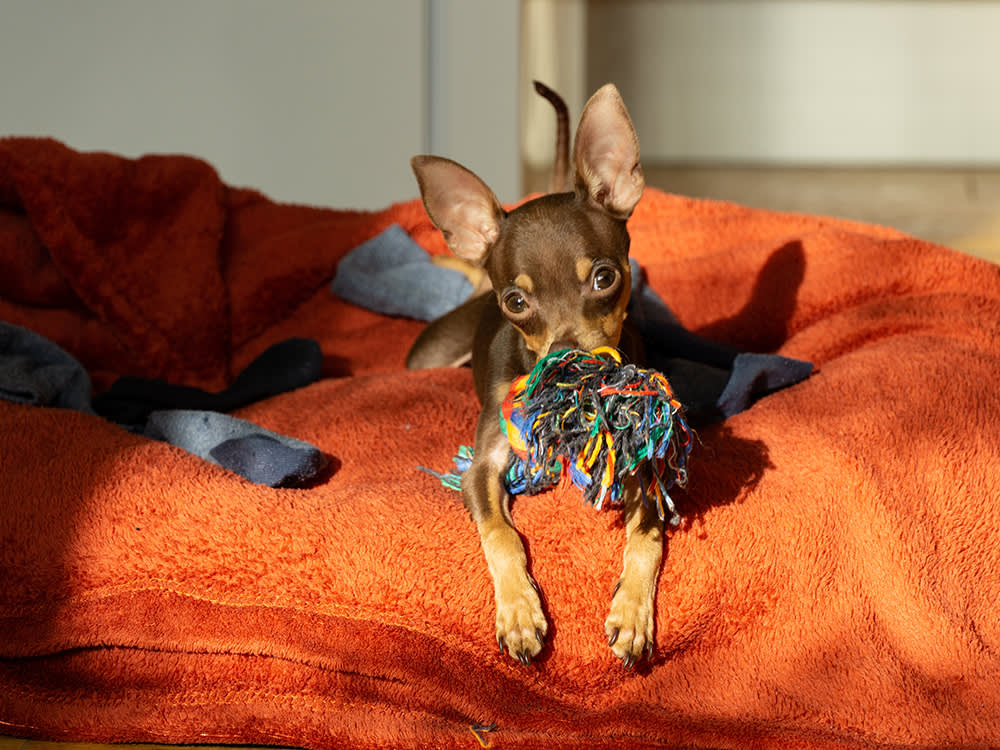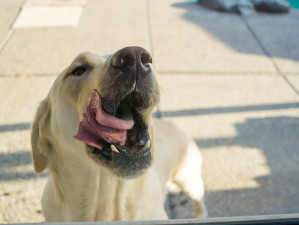“Help! How Do I Get My Dog to Stop Eating Socks”
How to get your pet to stop chewing on inedibles from clothes to couches.

Share Article
Lily is a one-year-old Lab mix who eats everything in sight — mostly socks. She has destroyed clothes, shoes, hair ties...my couch! Nothing I do stops this behavior. Even when I tried using a crate, she chewed the plastic tray at the bottom, then started chewing the floor through the crate bars. Recently, she had emergency surgery to remove a child’s sock. She gets a ton of attention and has a large yard to roam (where she digs holes). What should I do? — Amanda
Your dog is adorable (obviously). Not so cute? Her appetite for eating more than just food — socks, shoes...your couch. Nobody wants their dog to be a picky eater, but you do want them to be discriminating enough to draw the line at things that are not food, since a) it’s dangerous for dogs to eat socks and other non-food items, and b) it’s a considerable financial strain. Here are some suggestions to minimize both the danger and the expense, and to hopefully stop Lily from eating dangerous items.
Keep Inedibles Out of Reach
Helping your dog stay safe (and keeping yourself sane!) will always involve some management. To keep her insides free of items that should remain on the outside, keep her favorite inedibles out of reach. I’m not suggesting that you Marie Kondo your home to the point that visitors think Lily is the only thing that “sparks joy” for you, but known offenders have to be unattainable. This might be a lot easier said than done.
How much do you spend on your pet per year?

A deterrent such as a citrus or bitter appleopens in new tab spray might work; if it does, feel free to use it (honestly, since they rarely seem to be effective with such eager eaters, I’d be surprised if it did, but would feel irresponsible if I didn’t mention it).
Add Stimulation to Your Dog’s Life
Some dogs develop a habit of swallowing strange things (also known as pica in dogs) out of boredom; a dog looking for something to do often explores with their mouth, and for some, ingestion of the treasure is their next logical step. Adding stimulation to Lily’s life can help with this, so try to add more fun and activity to her days. Consider new activities such as agility, obstacle courses, nosework, more walks or outings, short training sessions throughout the day, play sessions, or car rides.
Another option is to feed her via sturdy enrichment toys: Dogs need to be able to chew on things that they can’t swallow or that are digestible if they do eat them. Kong toys in the largest size are a good choice for many dogs. Stuff one with wet food, freeze it, and then give it to her. If she is a voracious eater, talk to your veterinarian first and supervise her whenever she has such an item.
Use Reinforcement Training
While it’s not a quick fix, positive reinforcement training can also help. Improving Lily’s response to “drop it” and “leave it” is important so that any possessive behavior (you can’t take it away if it’s in my belly!) doesn’t lead to harm. Start using these cues with items that she is not very excited about and that are too big to be swallowed. Use the tastiest treats you can find so it’s worth it to her to do the right thing. Trading up (“give me that mediocre item and I will give you this far better one”) is a great way to improve this behavior.
Another training strategy: If seeing you head toward them prompts Lily to swallow things she shouldn’t, instead of chasing her down, encourage her to move away from items that pose a risk. To do this, toss a handful of treats to another spot in the room so she has to get up to get them. Then retrieve the sock while she munches away.
Give Your Dog More Exercise
Though it’s not the cure all it is sometimes made out to be, exercise can certainly help. Dogs who are tired and content from a hard effort, preferably off leash (in your yard or other fenced-in area), are less likely to get into whatever trouble they are prone to find, and they are more likely to sleep.
If All Else Fails, Hire a Trainer to Help
I know how hard it can be to keep Lily from eating everything in sight. Hopefully some of these tips work so she can enjoy the world in safe ways from here on out — and you can stop worrying about replacing items she’s chewed up. If not, go back to basics with Kinship’s free dog obedience courses or look into local certified trainers to help lend a hand in person.

Karen B. London, PhD, CAAB, CPDT-KA
Karen B. London is a certified applied animal behaviorist (CAAB) and certified professional dog trainer (CPDT) who specializes in working with dogs with serious behavioral issues, including aggression. She has written for a variety of magazines including The Bark, Clean Run, and the APDT Chronicle of the Dog, and has published in scientific journals including Behavioral Ecology and Sociobiology, Ethology, Ecology, and Evolution, the Journal of Insect Behavior, and Insectes Sociaux. She is the author of seven books about dog training and canine behavior, including the forthcoming My Dog's Mystery Adventure: And Other Stories From a Canine Behaviorist and Dog Trainer.



